The Korean War began on June 25, 1950 when the communist nation North Korea invaded South Korea.
With this invasion, the United States of America feared the spread of communism and sought permission from the United Nations to support the South Korean government. The UN granted the permission to the US to send troops to free South Korea from North Korea’s military occupation. The soldiers fighting for South Korea, many of them were members of the US military, were under the direct control of the UN.
Approximately 1,000,000 South Koreans were killed in the conflict. A slightly larger number of North Koreans lost their lives. Almost 34,000 Americans died, with around 100,000 soldiers suffered non-fatal wounds. At the end of the Korean War, more than 8,000 Americans were missing in action.
Most war historians said that the Korean War was a draw. But some historians said that the United States, through the UN, succeeded in freeing South Korea from communism. But it was a very costly victory.
With her brother on her back, a war-weary Korean girl trudges by a stalled M-26 tank, at Haengju, Korea. on June 9, 1951.
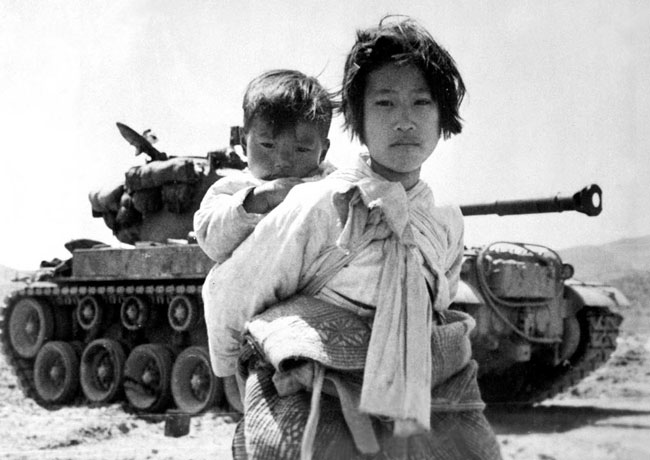
Photo credit: U.S. Navy / AP / Korean Central News Agency
In this undated photo from North Korea’s official Korean Central News Agency, distributed by Korea News Service, North Korean combatants plunge together with the tank unit in Seoul during the Korean War.
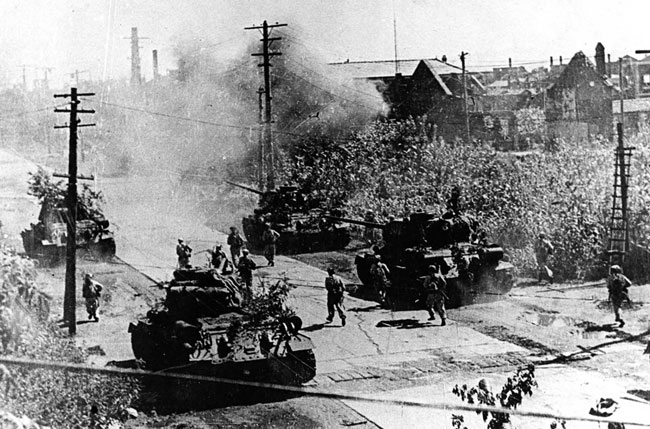
Photo credit: U.S. Navy / AP / Korean Central News Agency
In this undated photo from North Korea’s official Korean Central News Agency, American combatants captured during the Korean War march down a street.
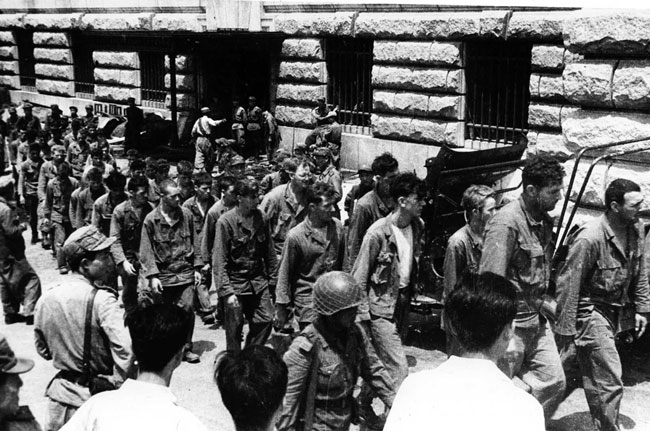
Photo credit: U.S. Navy / AP / Korean Central News Agency
Tank landing ships unload at Inchon on September 15, 1950. American forces landed in Inchon Harbor one day after Battle of Inchon began.
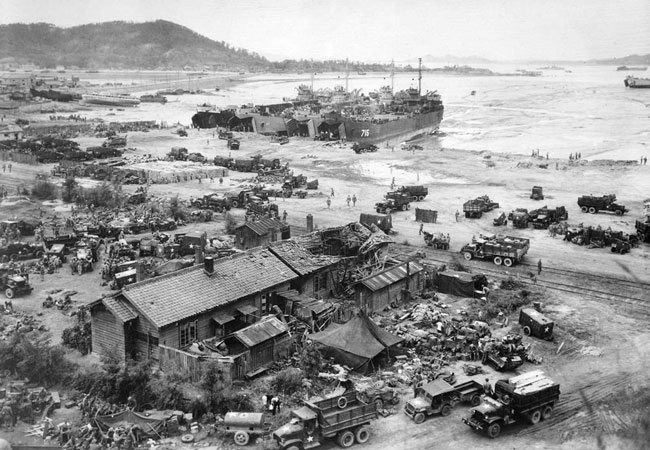
Photo credit: U.S. Navy / AP / Korean Central News Agency
Troops of the 31st Infantry Regiment land at Inchon Harbor, Korea, aboard LSTs on September 18, 1950.
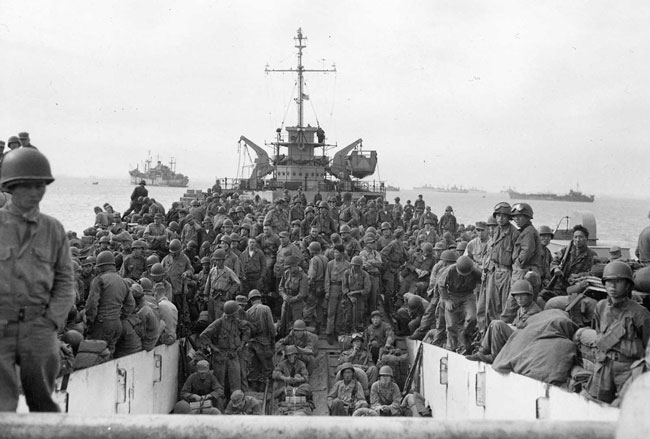
Photo credit: U.S. Navy / AP / Korean Central News Agency
A young officer and his wife sit in their car at the dock and stare quietly at the waiting aircraft carrier before he leaves for Korea. San Diego, California, 1950.
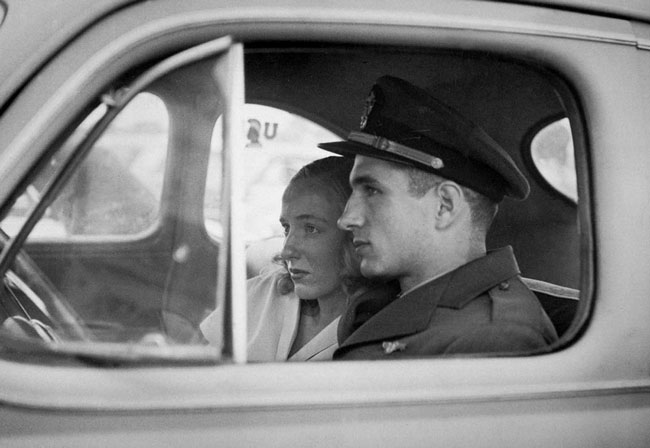
Photo credit: U.S. Navy / AP / Korean Central News Agency
Singer Paul Robeson addresses a “Hands Off Korea” rally from a sound truck at the corner of 126th Street and Lenox Avenue in the Harlem section of New York, on July 3, 1950.
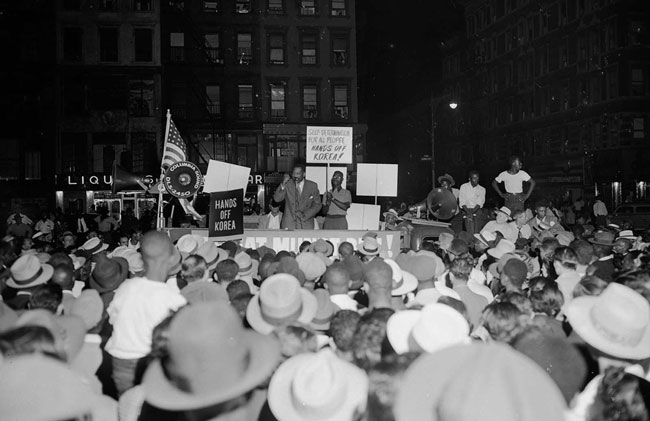
Photo credit: U.S. Navy / AP / Korean Central News Agency
This picture was taken by a USAF RF-80 photo reconnaissance plane of actual strafing attacks by 5th Air Force planes on North Korean targets. This shows a small village housing North Korean vehicles and troops. Burning jeep in the background and a T-3V Tank.
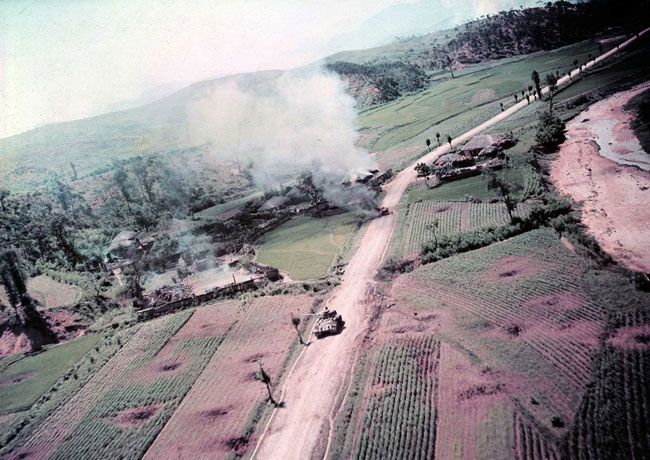
Photo credit: U.S. Navy / AP / Korean Central News Agency
A U.S. Marine (right) orders captured North Koreans to keep their hands up on September 20, 1950. In the background is one of the tanks which came ashore in the assault at Inchon.
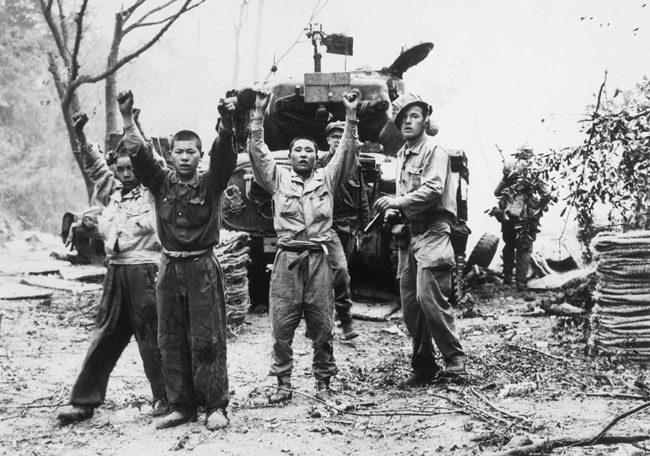
Photo credit: U.S. Navy / AP / Korean Central News Agency
A Korean child sits in smoldering ruins of his home destroyed by fire in the Suwon area on February 3, 1951, as allied troops burned dwellings which might provide shelter for red troops. Native water jars are the only possessions recognizable in ruins of other native homes in background.
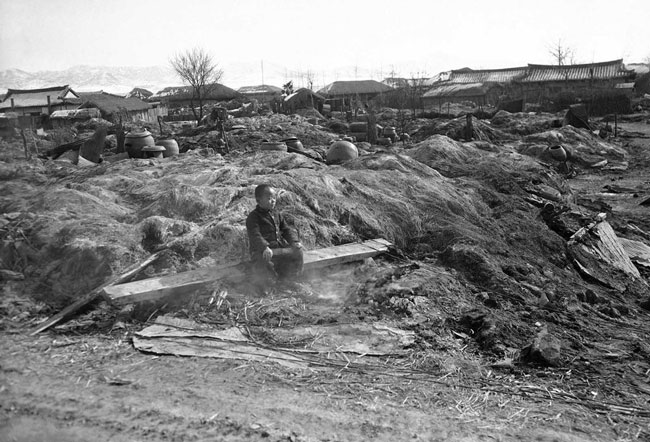
Photo credit: U.S. Navy / AP / Korean Central News Agency
A U.S. Marine tank follows a line of prisoners of war down a village street. September 26, 1950.
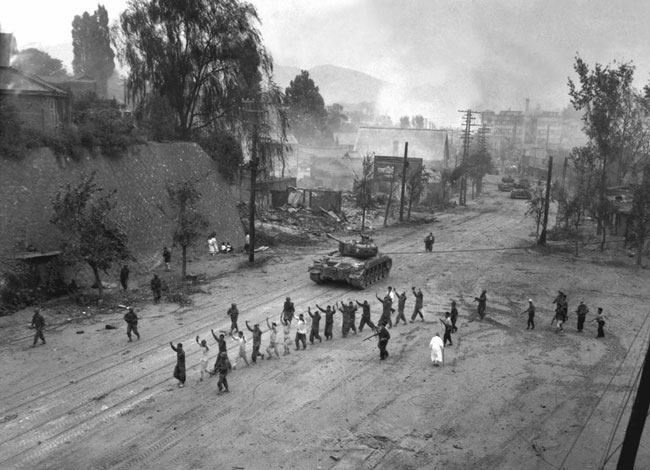
Photo credit: U.S. Navy / AP / Korean Central News Agency
Captured by American forces in the Taegu area of South Korea on October 8, 1950, these North Korean girls are marched to a train which will take them to a prisoner of war camp at Pusan.
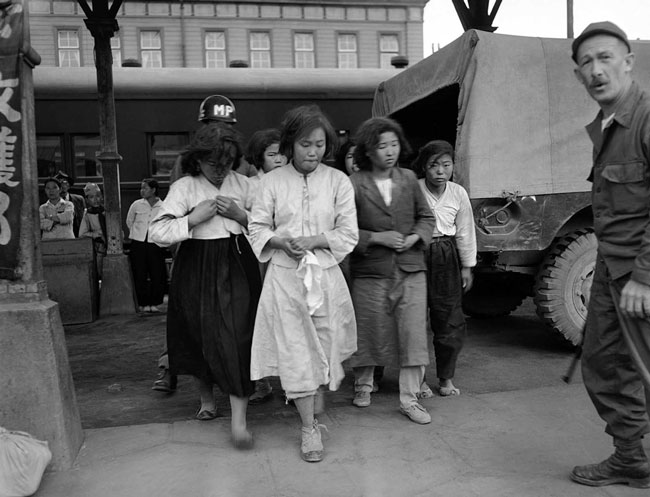
Photo credit: U.S. Navy / AP / Korean Central News Agency
Helicopters were used on the battlefront as liaison planes and for evacuating the wounded. Here, one of the helicopters takes off over the heads of First Marine Division troops in a forward position on a mountain slope.
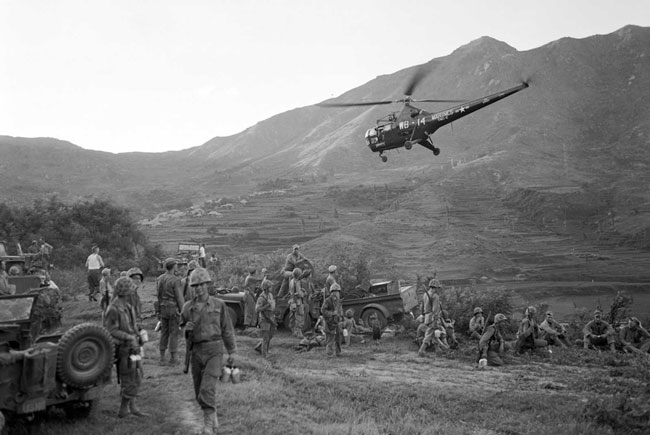
Photo credit: U.S. Navy / AP / Korean Central News Agency
A mobile army surgical hospital somewhere in Korea on October 26, 1951. The patient in the left foreground is receiving blood plasma, while behind him two operations are taking place, one at left and one in the center. Photographer Healy took the photos as he found them. Everyone was so busy that no one had time to pose.
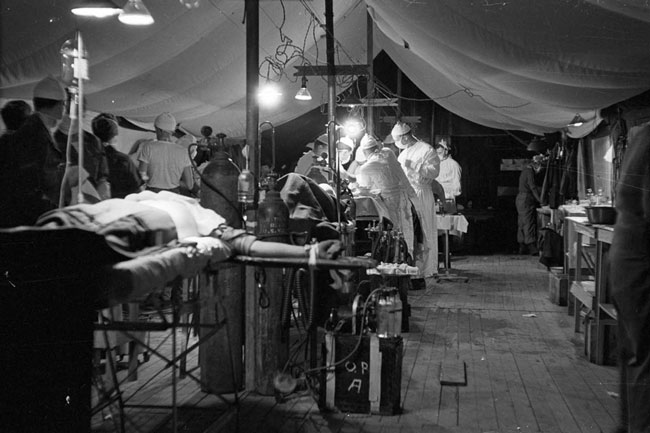
Photo credit: U.S. Navy / AP / Korean Central News Agency
Three Korean Communists in a fishing boat are captured by the USS Manchester off the coast of Korea on May 10, 1951.
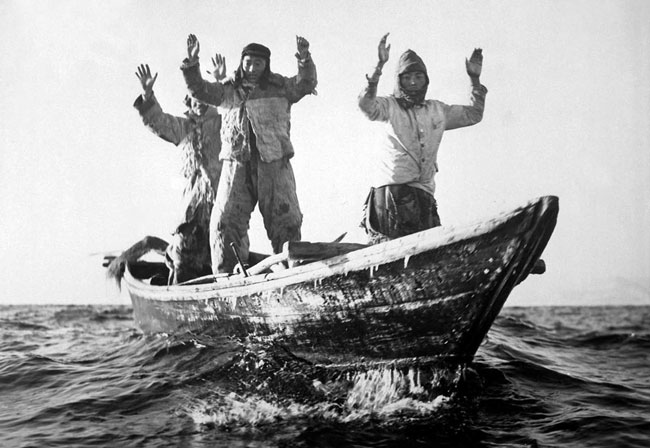
Photo credit: U.S. Navy / AP / Korean Central News Agency
A command post somewhere in South Korea on July 12, 1950, as American soldiers keep on the alert with their straw covered camouflaged weapons carrier.
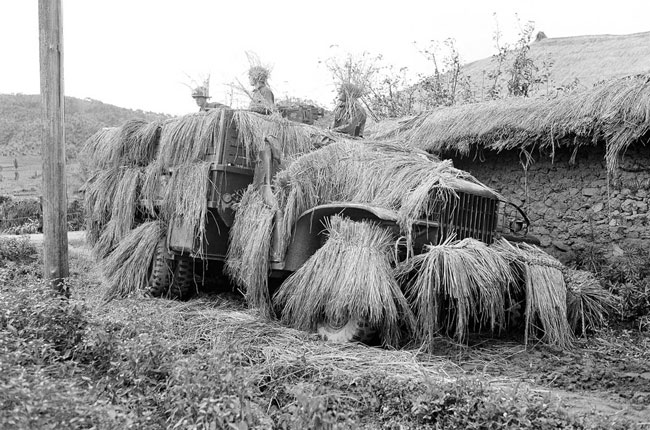
Photo credit: U.S. Navy / AP / Korean Central News Agency
F9F-2 floating on water after crash over bow of USS Philippine Sea (CV-47) near Korea. Cdr. R. Weymouth stands on the nose of the plane awaiting rescue.
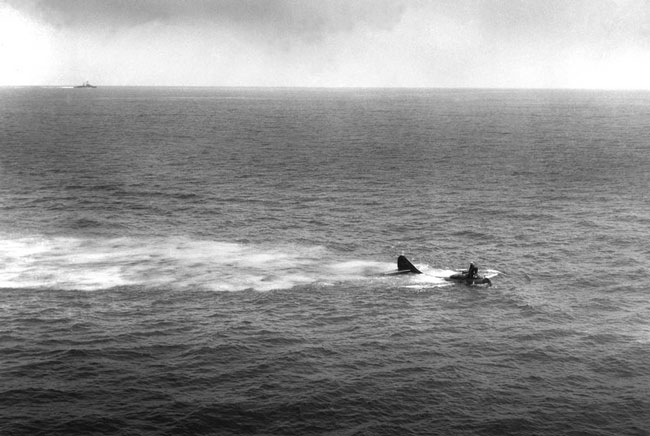
Photo credit: U.S. Navy / AP / Korean Central News Agency
Crew members of a marine battery launcher hold their ears and crouch to the ground as rockets are fired into the night sky.
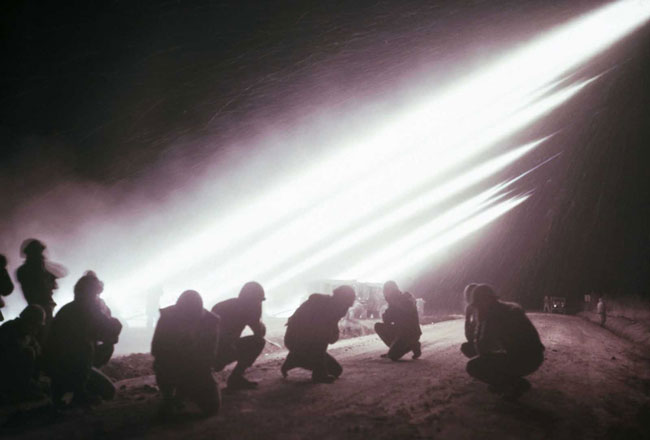
Photo credit: U.S. Navy / AP / Korean Central News Agency
Soldiers digging into bunkers atop Old Baldy in Korea in 1952.
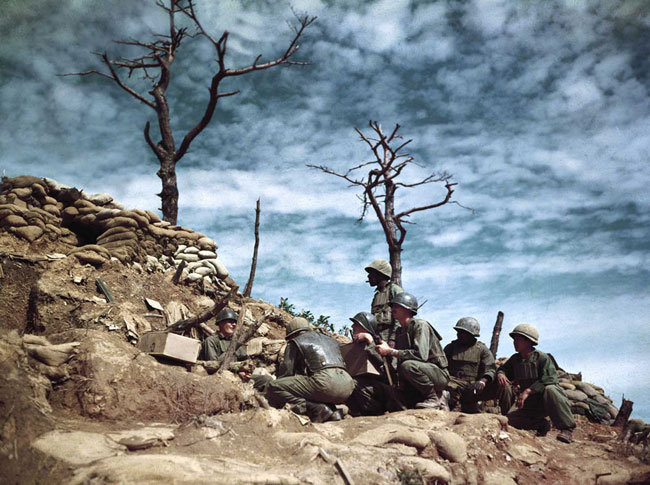
Photo credit: U.S. Navy / AP / Korean Central News Agency
Lt. R. P. Yeatman, from the USS Bon Homme Richard, rocketing and bombing a Korean bridge in November of 1952.
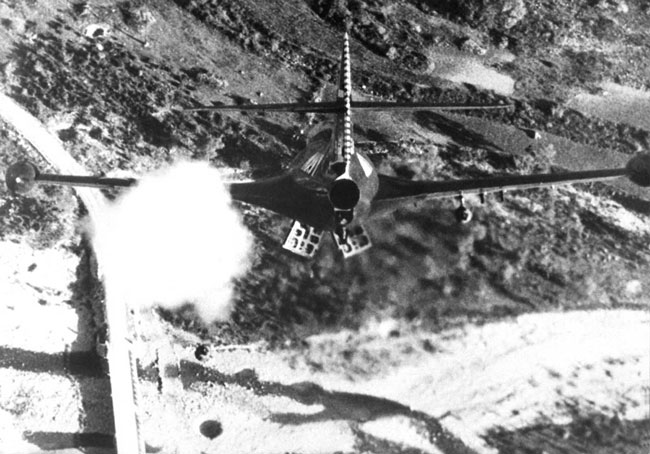
Photo credit: U.S. Navy / AP / Korean Central News Agency
Supply warehouses and dock facilities at this east coast port explode after para-demolition bombs were dropped from the Fifth Air Force’s B-26 Invader light bombers. Wonsan, North Korea, 1951.
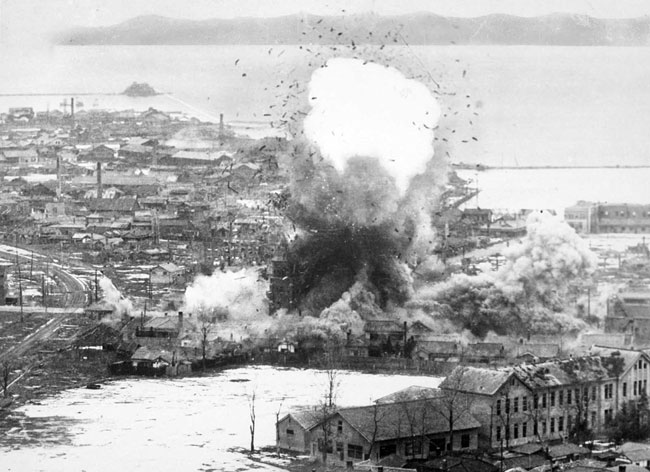
Photo credit: U.S. Navy / AP / Korean Central News Agency
A U.N. soldier (left) stands guard at prisoner of war enclosure where a great mass of communist troops line up after their capture somewhere in Korea on March 21, 1951.
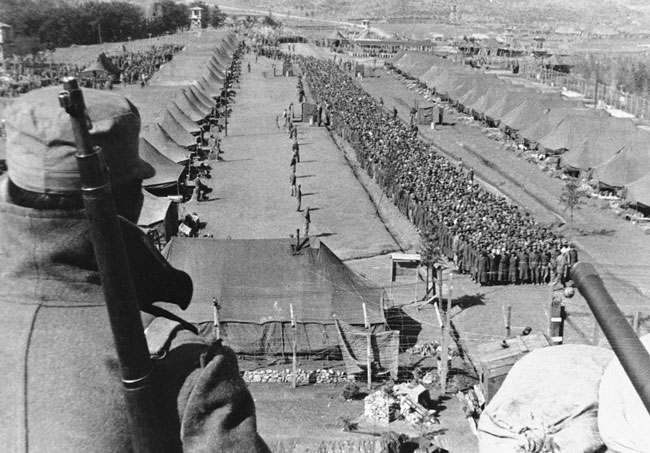
Photo credit: U.S. Navy / AP / Korean Central News Agency
Pfc. Milton Reince of Green Bay, Wisconsin, adds a picture of Mitzi Gaynor to his bunkerful of pinups at his post in Korea on December 18, 1952.
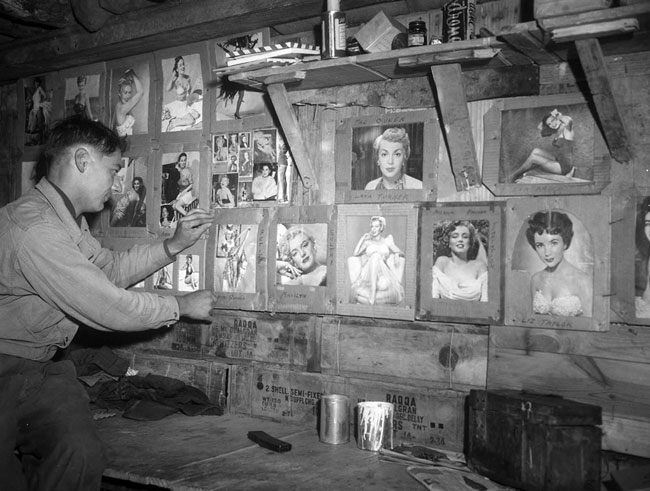
Photo credit: U.S. Navy / AP / Korean Central News Agency
Crew members stand on top of their tank after they got stranded in river bed dip as they attempted to find a shallow crossing in the swollen Pukhan river. The tank was later towed out to safety by a tank retriever, April 7, 1951 in Korea.
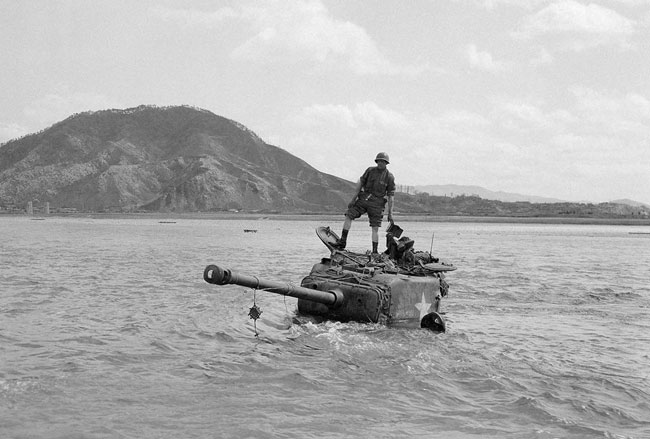
Photo credit: U.S. Navy / AP / Korean Central News Agency
Bomber Command planes of the U.S. Far East Air Forces rain tons of high demolition bombs on a strategic military target of the Chinese Communists in North Korea on January 18, 1951.

Photo credit: U.S. Navy / AP / Korean Central News Agency
South Korean WACs trained and ready to join their men in the battle against Chinese invaders, display military precision as they parade through Pusan, main United Nations’ fort city in Korea, on September 12, 1950.
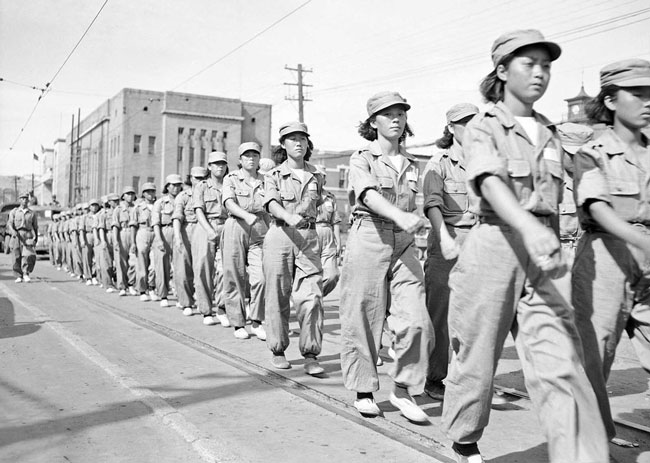
Photo credit: U.S. Navy / AP / Korean Central News Agency
High explosives rip through several spans of a railroad bridge outside Hamhung as United Nations forces blow up the bridge as part of their withdrawal to prevent its being used by Chinese Communists on December 19, 1950.

Photo credit: U.S. Navy / AP / Korean Central News Agency
American GIs thread their way over snow-covered hills North of Seoul, South Korean capital on January 14, 1951, during earlier stages of U.N. withdrawal.
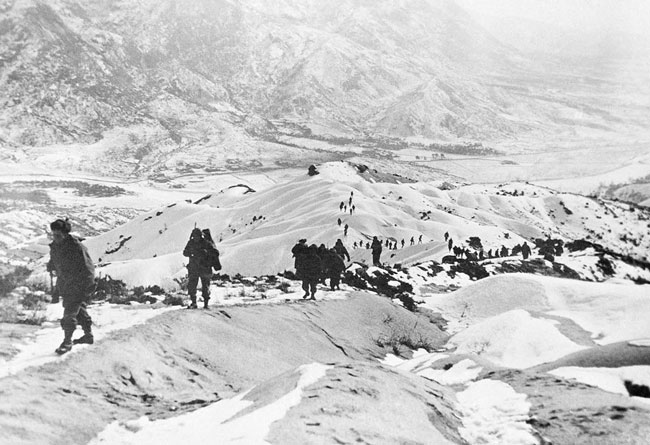
Photo credit: U.S. Navy / AP / Korean Central News Agency
A pair of bound hands and a breathing hole in the snow at Yangji, Korea, January 27, 1951 reveal the presence of the body of a Korean civilian shot and left to die by retreating Communists during the Korean War.
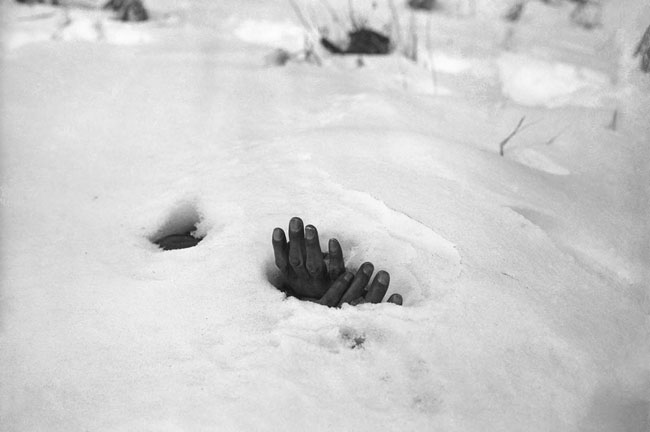
Photo credit: U.S. Navy / AP / Korean Central News Agency
All Sgt. Bernard Young lacks is a private secretary to complete his “office” setting, on May 3, 1951. The Detroit, Michigan, military policeman takes his ease in almost deserted Chunchon, South Korea after the bulk of UN forces had withdrawn southward. Only an infantry rear guard unit remained between him and the advancing Communists.
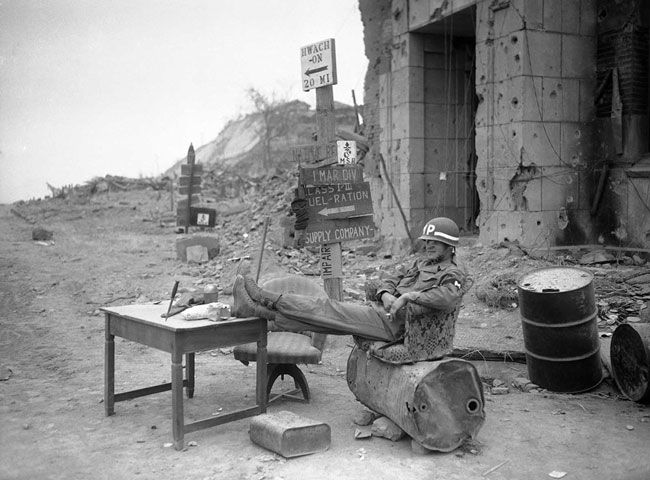
Photo credit: U.S. Navy / AP / Korean Central News Agency
Paratroopers drop from U.S. Air Force C-119 transport planes during an operation over an undisclosed location in Korea, in October of 1950.
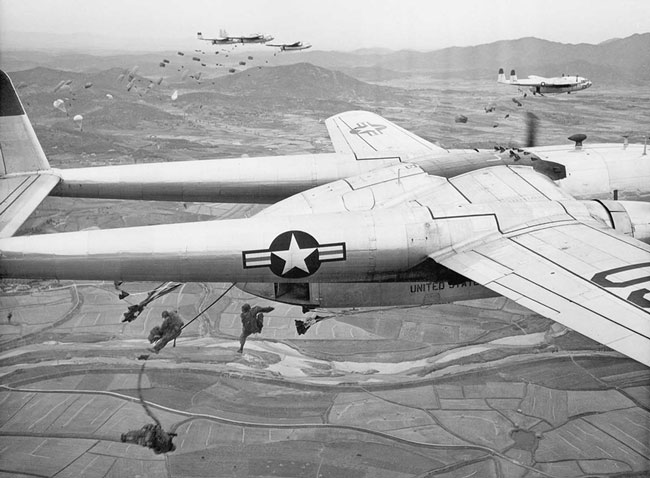
Photo credit: U.S. Navy / AP / Korean Central News Agency
A long winding stream of Korean refugees board a vessel in Hungnam harbor, North Korea on December 21, 1950, as they flee the advancing Chinese Communists and North Koreans.
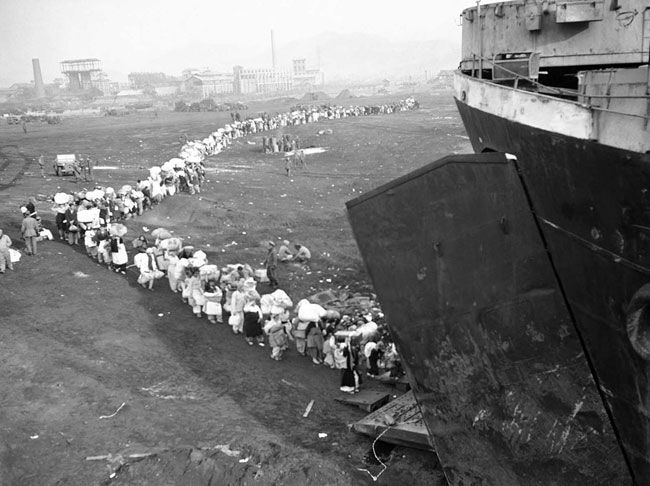
Photo credit: U.S. Navy / AP / Korean Central News Agency
Tanks of the 1st Marine Tank Battalion bark death and devastation into the briefly day-lighted Korean night, as Marines fire a night mission at supply installations somewhere in Korea on January 16, 1952.
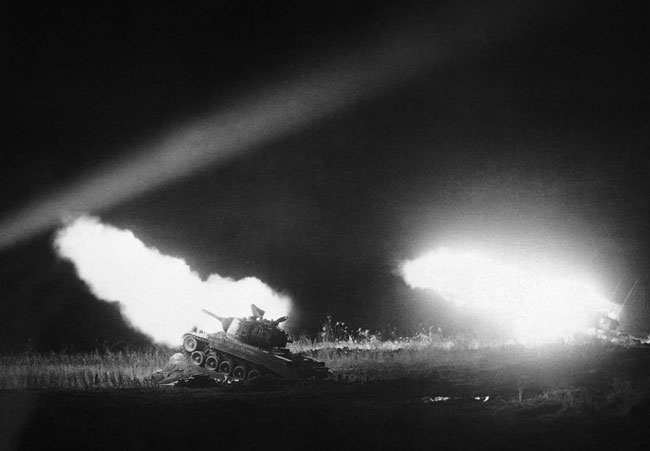
Photo credit: U.S. Navy / AP / Korean Central News Agency
The First Division Marines land at a seawall, far behind the lines of the communist forces, during the Landing at Inchon.
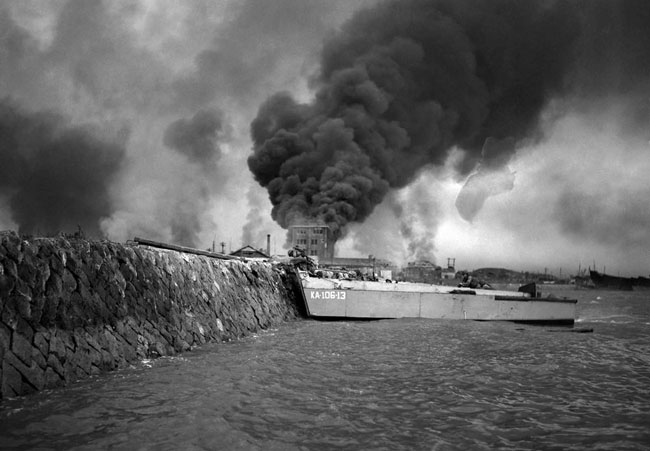
Photo credit: U.S. Navy / AP / Korean Central News Agency
GIs and Korean service corpsmen stack up an enormous pile of empty artillery and mortar shell casings at a collecting point near the front, pointing to the huge amount of lead thrown at the enemy in four days of fighting for outpost Harry, on June 18, 1953.
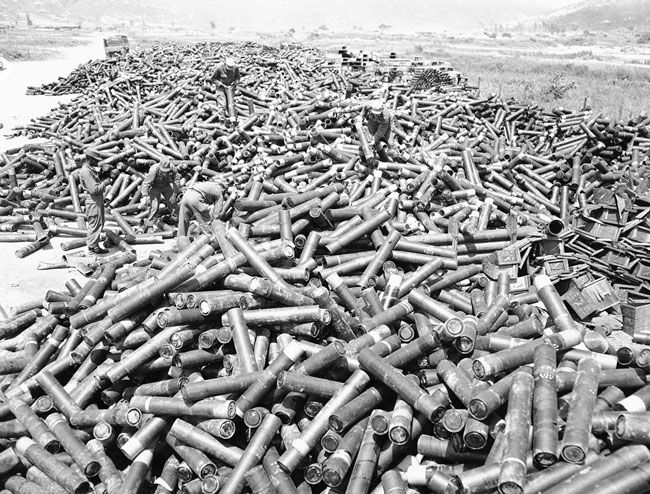
Photo credit: U.S. Navy / AP / Korean Central News Agency
Maj. Gen. Blackshear M. Bryan, left, exchanges credentials with Communist Lt. Gen. Lee Sang Cho at the opening session of the Military Armistice Commission at the Panmunjom Conference House on July 27, 1953. At Lee’s right is Chinese Gen. Ting Kuo Jo, and next to him is Chinese Gen. Tsai Cheng Wen.
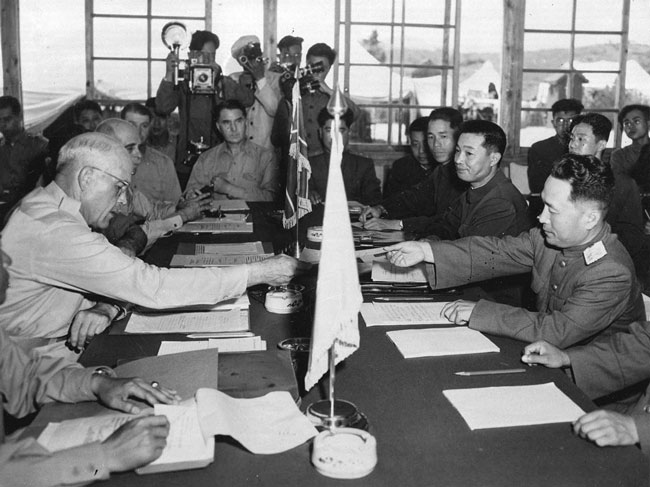
Photo credit: U.S. Navy / AP / Korean Central News Agency
Three happy fliers of the 18th Fighter Bomber wing let the world know how they feels as they returned from a combat mission over North Korea to learn of the armistice signing on July 29, 1953. Left to right are: 2nd Lt. John Putty, Dallas, Tex.; 1st Lt. James A. Boucek, Ottawa, Kansas,: and 1st Lt. Richard D. Westcott, Houston, Tex., waving from the back seat of the jeep.
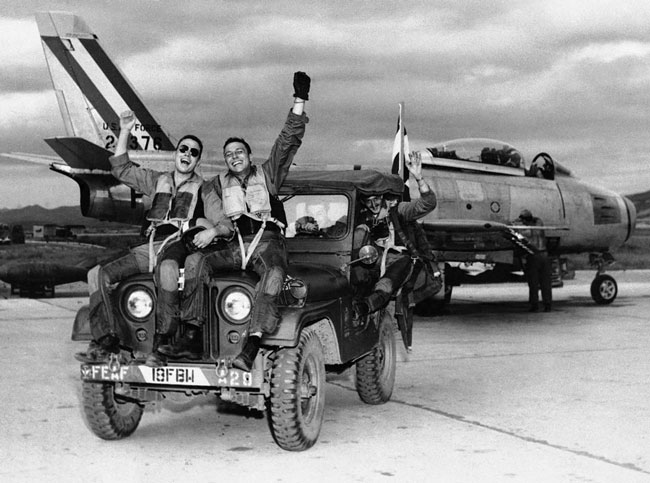
Photo credit: U.S. Navy / AP / Korean Central News Agency
South Korean women weep as they listen to President Syngman Rhee speak at a memorial service in Seoul, October 17, 1953. The service honored the 33,964 South Koreans killed in the last year of the war.
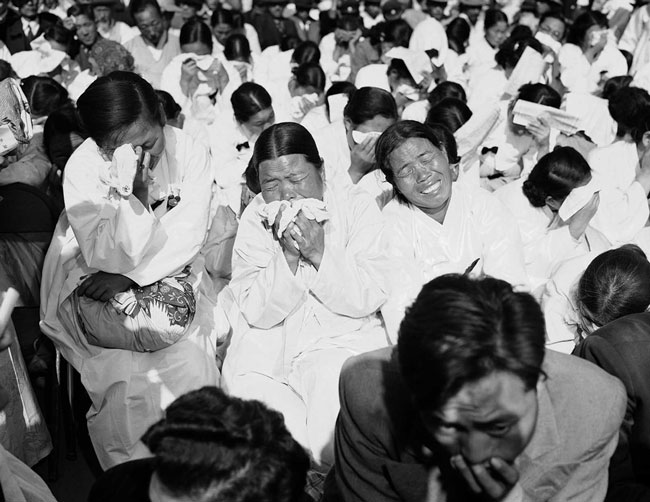
Photo credit: U.S. Navy / AP / Korean Central News Agency
PFC Donald Jones of Topeka, Kansas, pauses to read a sign just posted on the south limit of the demilitarized zone in Korea on July 30, 1953.
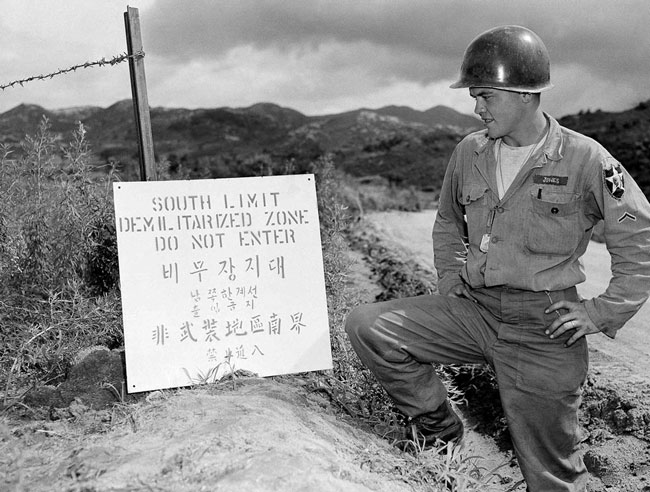
Photo credit: U.S. Navy / AP / Korean Central News Agency
